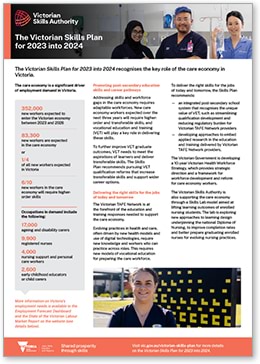This fact sheet provides summary information about the Victorian Skills Plan 2023 into 2024 specifically related to the care economy.
You can download a PDF copy or read an accessible version below.
Also see our other fact sheets related to the plan.
Downloadable care economy fact sheet
(opens in a new window)
Accessible care economy fact sheet
The Victorian Skills Plan for 2023 into 2024 recognises the key role of the care economy in Victoria
The care economy is a significant driver of employment demand in Victoria.
Key statistics from the Victorian Skills Plan for 2023 into 2024
- 352,000 new workers expected to enter the Victorian economy between 2023 and 2026
- 83,300 new workers are expected in the care economy or one quarter of all new workers expected in Victoria - or - 1/4 of all new workers expected in Victoria
- 6 out of 10 new workers in the care economy will require higher-order skills.
Occupations in demand
- 17,000 ageing and disability carers
- 9,900 registered nurses
- 4,000 nursing support and personal care workers
- 2,600 early childhood educators or child carers.
More information on Victoria’s employment needs is available in the State of the Victorian Labour Market Report 2023.
Promoting post-secondary education skills and career pathways
Addressing skills and workforce gaps in the care economy requires adaptable workforces. New care economy workers expected over the next three years will require higher-order and transferable skills, and vocational education and training (VET) will play a key role in delivering these skills.
To further improve VET graduate outcomes, VET needs to meet the aspirations of learners and deliver transferable skills. The skills plan recommends pursuing VET qualification reforms that increase transferable skills and support wider career options.
Delivering the right skills for the jobs of today and tomorrow
The Victorian TAFE Network is at the forefront of the education and training responses needed to support the care economy.
Evolving practices in health and care, often driven by new health models and use of digital technologies, require new knowledge and workers who can practice across roles. This requires new models of vocational education for preparing the care workforce.
To deliver the right skills for the jobs of today and tomorrow, the skills plan recommends:
- an integrated post-secondary school system that recognises the unique value of VET, such as streamlining qualification development and reducing regulatory burden for Victorian TAFE Network providers
- developing approaches to embed applied research in the education and training delivered by Victorian TAFE Network providers.
The Victorian Government is developing a 10-year Victorian Health Workforce Strategy, which provides strategic direction and a framework for workforce development and reform for care economy workers.
The Victorian Skills Authority is also supporting the care economy through a Skills Lab model aimed at lifting learning outcomes of enrolled nursing students. The lab is exploring new approaches to learning design underpinning the national Diploma of Nursing, to improve completion rates and better prepare graduating enrolled nurses for evolving nursing practices.
Updated


